Galactic Doomsday?
Dr. Paul LaViolette's Galactic Super Wave Theory
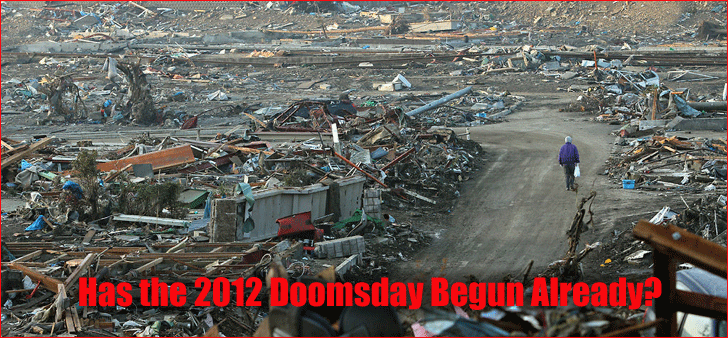
© 2011 By Gary Vey
Although he does not inject himself in to the 2012 controversy, Dr. Paul LaViolette has developed a theory that seems to explain many aspects of the "doomsday" scenario. These ideas were once considered "out there" by many scientists, mainly because they portrayed a world view that was full of apparent chaos and destruction. But in the last decade, his work has been validated -- often by his former critics -- and scientists are now realizing that chaos and destruction are endemic in the universe [7].
Glazed donuts on the Moon
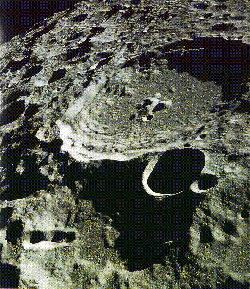
Let's begin back in the 1960s with the Apollo 11 manned landing on the moon. On one of their EVA's (extra-vehicular activities), the astronauts photographed and took samples from some small craters, about 20cm to 1.5 meters across. When they examined the floors of these craters they noticed what looked like glazed donuts. These were actually chunks of moon dirt that were coated by glass.
The glazed areas are clearly concentrated toward the top surfaces of protuberances, although they exist also on some sides. Points and edges appear to be strongly favored for the glazing process. In some cases, droplets appear to have run down an inclined surface for a few millimeters and congealed there. [1]
But in 1969, an article in Science by T. Gold [1] proposed a theory of how they were made. Glass, as we know, is made from melting sand. It occurs naturally near sources of high temperature, such as volcanos and meteor impacts. The atom bomb tests in New Mexico's White Sands area produced a small "lake" of glass at ground zero. So it was never a question about the lunar glass also having been created by something very hot.
The fact that the glaze was confined to small patches, 0.5 to 10mm, suggested to scientists that the surface had been zapped rather than slow-cooked. And the likely source of this zap was our Sun. Gold estimated that the solar luminosity would have had to increase by 100 times what it is normally, for a duration of from 10 to 100 seconds.
Also, because of the lack of debris or dirt covering this glass, it must have occurred within the last 30,000 years. This made Gold propose that the Sun -- our Sun -- does this every 10,000 years or more. He suggested that future research should look for a "trigger" event -- possibly a large comet or asteroid impacting the surface of the Sun. He estimated this would only have to be 100 km and weigh 3 x 1021 grams.
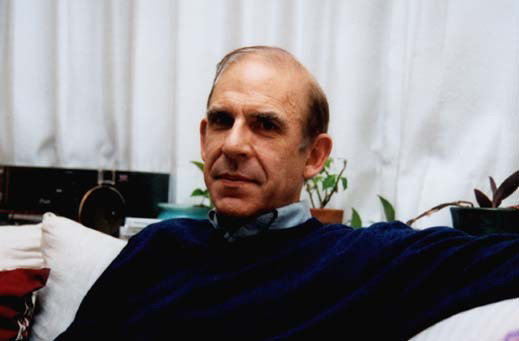 Decades passed and this theory didn't receive much attention. Then, as it often does, the theory got a fresh look by a genius, Dr. Paul LaViolette. He was not satisfied with the source of the glass being caused by a solar blast, mainly because the output would have had to be on the scale of a nova, not just a flare. He envisioned another possibility.
Decades passed and this theory didn't receive much attention. Then, as it often does, the theory got a fresh look by a genius, Dr. Paul LaViolette. He was not satisfied with the source of the glass being caused by a solar blast, mainly because the output would have had to be on the scale of a nova, not just a flare. He envisioned another possibility. LaViolette envisioned a large solar flare or coronal mass ejection (CME) that would become magnetically entrapped in the Earth's magnetosphere [2]. The magnetosphere would then hold on to this fireball of radiation like a magnetic thermos bottle, allowing the Moon and Earth to be exposed for a duration of time long enough to really "flash bake" their surfaces.
Critics quickly denounced Gold's propositions citing evidence of "cosmic dust" and rare elements in the lunar glass and concluding that the heat source was from a meteor impact. [3]
But LaViolette proposed that this cosmic dust was likely present on the surface of the Moon during the time it was melted into the glass. In fact, he proposed that the entire solar system was full of this cosmic dust at the time of this solar eruption. He was vindicated when polar ice cores showed unusual cosmic dust deposits at strata marking the end of the last ice age [4]. This time period, about 12,950 BCE [10], approximates the current age of the Moon glass and the intense heat that must have produced it. So where did all this cosmic dust come from?

Like Earth, our entire solar system has its own atmosphere, called the heliosphere. This "bubble" surrounds the Sun and planets as it travels through galactic space. Like our earth's magnetosphere, the movement of the heliosphere creates a rounded "head" and a narrowing "tail" (called the heliopause). Actually, it's more egg shaped (see above). Until recently, astronomers believed that our solar system was a region relatively free from cosmic dust. The cosmic dust and frozen material of space were kept outside this protective bubble.
This was confirmed when the IRAS and Ulysses spacecrafts showed infrared images of the solar system, surrounded by whispy clouds of cosmic dust that increase in density just beyond Saturn.
So if the cosmic dust is surrounding the heliopause, what would make it suddenly enter the heliosphere and how would this coincide with huge solar flares? LaViolette envisioned something disrupting the heliosphere from the outside, impacting it and drawing cosmic dust inside with it and energizing the Sun. The energy of such an impact would be immense. The most logical place to look for such enormous energy was the Milky Way Galaxy.
The smoking gun
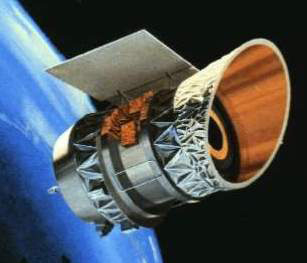
Examining the shape of the cosmic dust clouds, the IRAS satellite team reported that the cloud was tilted relative to the solar system's ecliptic -- the narrow plane containing our planets. LaViolette realized that this odd alignment tracked back to the Galactic center. This was quickly verified by NASA's Ulysses spacecraft and New Zealand's AMOR space radar observatory. Whatever caused the last ice age to end, the Sun to flare up and caused the glass to form on the Moon, came from the center of the Milky Way Galaxy. The plot was getting more interesting.
Astronomers have known about intense radiation from space since the 1970s. Multiple bursts of powerful gamma rays were routinely detected and believed to originate from stars in the Milky Way. Assuming this energy originated locally, astronomers concluded this type of gamma ray burst was insignificant and harmless. Then, in December 1997, they had the technology and good luck to catch a strong gamma ray burst and track it. The source was not inside the Milky Way Galaxy. It was from a distant galaxy billions of light years away.
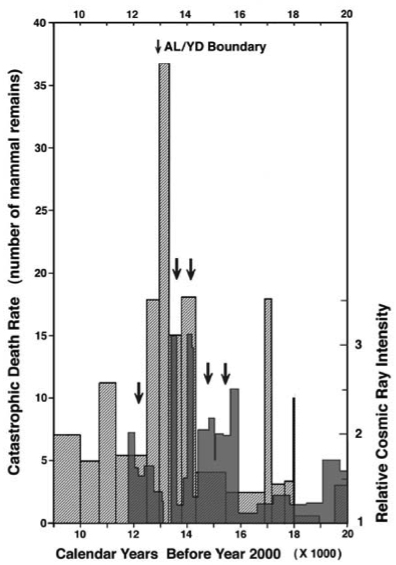 A review of other bursts showed that their assumptions had been wrong. All of the gamma ray bursts they were observing were from other galaxies far, far away. The amount of energy coming from objects so distant was a real shock. No one had ever imagined such powerful bursts could be generated by galactic centers. The thought of a burst coming from our own Milky Way galactic center was abysmal. A burst of the same intensity as the 1997 event, originating from inside the Milky Way, would deliver 100,000 time the lethal dose of radiation, killing every life form that was exposed. Could that really happen to us?
A review of other bursts showed that their assumptions had been wrong. All of the gamma ray bursts they were observing were from other galaxies far, far away. The amount of energy coming from objects so distant was a real shock. No one had ever imagined such powerful bursts could be generated by galactic centers. The thought of a burst coming from our own Milky Way galactic center was abysmal. A burst of the same intensity as the 1997 event, originating from inside the Milky Way, would deliver 100,000 time the lethal dose of radiation, killing every life form that was exposed. Could that really happen to us? This question was answered on August 27th, 1998 when an unusual 5 minute gamma ray pulse was located just 20,000 light years away in the constellation of Aquila. This may sound like a huge distance, but to astronomers this is just "next door." The Milky Way Galaxy, for example, is just 100,000 light years from end to end and Earth is just 23,000 light years from our Galaxy's center.
The 1998 event was close enough and strong enough to ionize Earth's upper atmosphere, damage a couple of spacecraft and disrupt global communication. Since then astronomers place gamma ray bursts from the Galaxy's core at the top of the list of things we don't want to happen.
Before Aquila, scientists just feared exploding stars -- novas and supernovas. Now things are different. It's like living in a ghetto and fearing drive-by shootings and random bullets. Then one day you learn that there's a nuclear bomb down the street, waiting to explode.
Ancient warnings from past experience
The Hopi are an Native American Indian tribe who have not sold out or assimilated in our modern culture. They view themselves as the "keepers of the truth" about our purpose and place in the universe. Anyone who has ever visited their small reservation in Arizona has experienced how private they are -- forbidding photographs or copies of their art and culture. For centuries they have kept an oral tradition which describes human history in terms of "worlds" -- successive eras which end in natural disasters, culling humanity and initiating a rebirth of civilization.
According to their teachings, the Hopi describe three prior worlds. We are currently in the fourth world, about to enter the fifth.
The Hopi elder, White Feather, of the spiritually important Bear Clan, describes nine different signs signaling the end of this Fourth World. Some believe all but the last sign has already happened. The final warning is as follows:
"And this is the Ninth and Last Sign: You will hear of a dwelling-place in the heavens, above the earth, that shall fall with a great crash. It will appear as a blue star. Very soon after this, the ceremonies of my people will cease." --www.burlingtonnews.net/hopiprophecy.html
"When he opened the sixth seal, I looked, and behold, there was a great earthquake, and the sun became black as sackcloth, the full moon became like blood... -- Revelations 6:12
| LaViolette... in his own words Question: Would you please prepare number (range of years) that represents the statistically most significant window for the next galactic center energy burst, based upon observed historical data. Dr. Paul LaViolette: A conservative guess would be that there is a 90% chance that a superwave will arrive in the next four centuries. I cannot rule out the possibility that one might arrive around the time of the Mayan calendar end date of 2012, as some proclaim. And others have felt that a catastrophic event might occur even sooner. It is just that investigations of the Galactic center mass (Sagittarius A) show that the core continues in its present quiescent state. Whether this present tranquil state will without warning come to a sudden end, I cannot say. All we can do at present is talk of future probabilities by looking at what has happened in the past. A study of the past shows that we are overdue for a small event, one similar to the bursts that resulted in the 14 gas expulsions which issued from the Galactic center over the past 5300 years. It has been 700 years since the last event and on only two occasions was there a time lapse between events longer than this. Whether the next event will be a small superwave event (Magnitude 1 event) or a much larger climatically significant event (Magnitude 3 or 4 event) is difficult to say. In referring to past events, it helps to use a magnitude scale as is used in describing the strengths of earthquakes and tornadoes. However, since we do not have real time data, such a scale is understandably very qualitative. We might rank the severity of Galactic superwaves as given below. Galactic Superwave Event Ranking Magnitude 1: A superwave cosmic ray burst that is not detectable above cosmic background levels but which carries a gamma ray burst and gravity wave pulse at its forefront. This would likely produce seismic and EMP effects much stronger than the December 2004 earthquake and gamma ray burst. Magnitude 2: A short duration superwave cosmic ray burst that produces a moderate increase above cosmic background levels and a minor climatic disturbance. This would be similar to the events that occurred around 5300 years ago which produced approximately a 50% increase in the cosmic ray background over a period of about one to two hundred years. This resulted in some temporary climatic change such as blizzards, but was not severe enough to perturb climate from its present interglacial phase. Magnitude 3: A long duration superwave cosmic ray burst that produces a major increase in the cosmic ray background level, doubling the background level, lasting several hundred to a thousand years, and injecting interstellar dust in sufficient quantities to destabilize climate initiating a period of glacial growth. Examples would be the events that initiated glacial stage 5-d about 110,000 years ago or stage 4 about 70,000 years ago. Magnitude 4: A much longer duration superwave cosmic ray burst capable of increasing the cosmic ray levels 2 to 4 fold above the background level and lasting several thousand years, with dust injection into the solar system maintained long enough to activate the Sun into a state of excessive flare activity. Such an event would induce climatic effects more extreme than a Magnitude 3 superwave, sufficient to initiate a global warming period that would terminate an ice age or induce an interstadial. Examples would be the superwave events that ended the Illinoisan glaciation (stage 6) about 130,000 - 140,000 years ago or ended the Wisconsin ice age about 16,000 - 10,000 years ago, the more recent precipitating the Pleistocene extinction. Another event around 34,000 - 37,000 years ago [11] occurred around the time of the demise of Neanderthal Man. |
Is the next cycle coming in 2012?
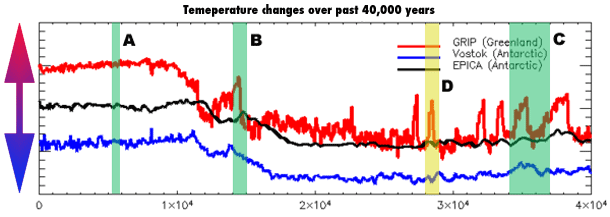
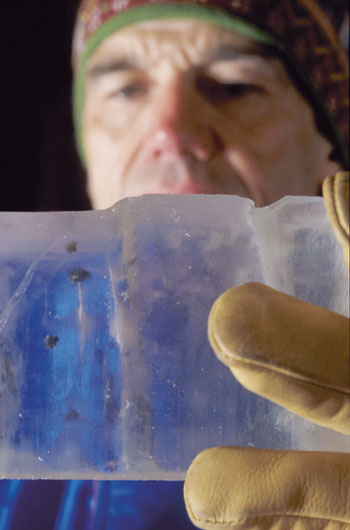 Ice core samples support evidence of the effects from cosmic dust corresponding to the years 11,880 to 11,785 BCE [B]. This evidence, along with the Moon glass, the presence of cosmic dust and the abrupt and atypical end of the last ice age -- all point to an intimate relationship between extreme solar activity and gama radiation from the Milky Way Galaxy's center.
Ice core samples support evidence of the effects from cosmic dust corresponding to the years 11,880 to 11,785 BCE [B]. This evidence, along with the Moon glass, the presence of cosmic dust and the abrupt and atypical end of the last ice age -- all point to an intimate relationship between extreme solar activity and gama radiation from the Milky Way Galaxy's center.The magnitude 2 short duration event which happened 5300 years ago appears to have had little effect on the temperature [A].
The magnitude 4 event attributed to 34,000 to 37,000 years ago is a bit confusing and seems to be precipitated by an event closer to 38,000 years ago. In fact, there are several spikes which do not appear to fit any cyclical pattern and suggest that other unknown factors could also influence Earth's climate.
If we assume that 2012 will be one of these cycles, we then have about 14,000 years from the last huge Galactic Super Wave event. It might be helpful then look at what happened 14,000 years prior to this last Galactic event -- 28,000 years ago [D]. Yes, there is a spike there but it is followed by another one a thousand years later. Again there seems to be other factors involved.
Let's go even further back in time. The chart below shows the temperature variation for the last 420,000 years, taken from Antarctic ice core samples.
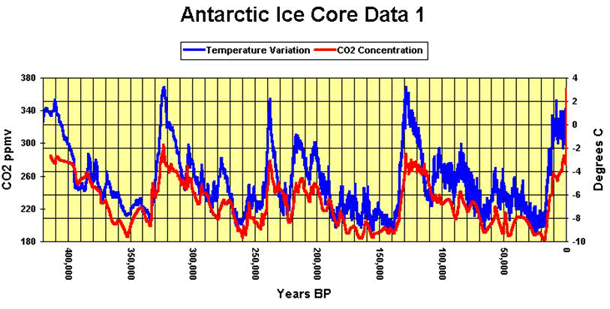
Galactic Bubbles Ahead!
The image below was made by the Fermi Telescope. It reveals a never before seen structure coming from our Galaxy's center. In fact, there are two gigantic bubbles which are emitting gamma and x-rays and seem to indicate that an enormous explosion has happened.
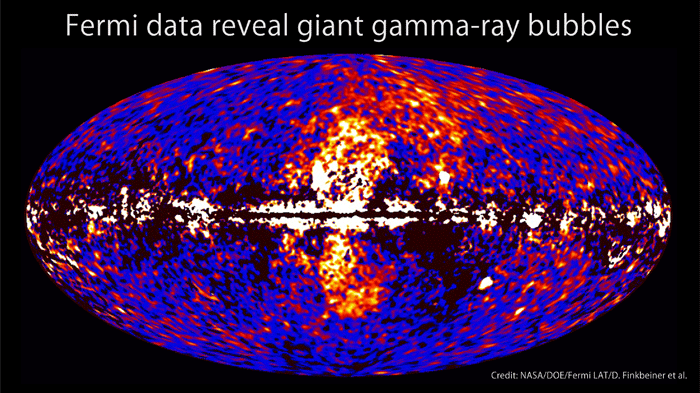
What we see are two gamma-ray-emitting bubbles that extend 25,000 light-years north and south of the galactic center... We don't fully understand their nature or origin." -- Doug Finkbeiner [8]
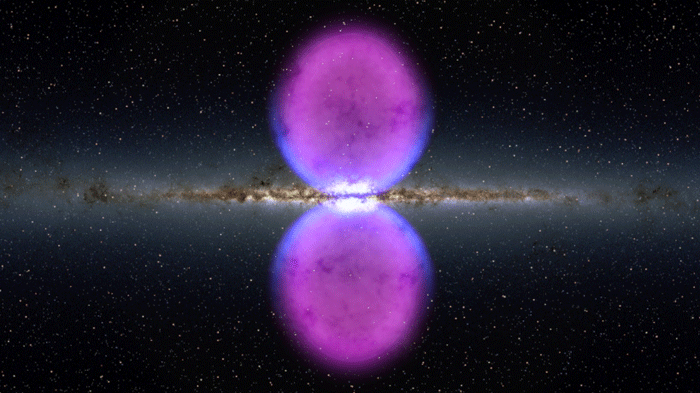
Prior to the launch of NASA's Compton Gamma-Ray Observatory, astronomers knew of only one galaxy that showed signs of gamma ray emissions from its core. Then they discovered dozens more. And with the latest Fermi Gamma-Ray Space Telescope they are seeing that this phenomenon is pretty much the norm for what are called "active galaxies."
Active galaxies are those with unusually bright centers that show evidence of particle acceleration to speeds approaching that of light itself. In 1943, astronomer Carl Seyfert described the first two types of active galaxy based on the width of spectral lines, a tell-tale sign of rapid gas motion in their cores. At the center of each active galaxy sits a feeding black hole weighing upwards of a million times the sun's mass. Through processes not yet understood, some of the matter headed for the black hole blasts outward in fast, oppositely directed particle jets. This could be what we are seeing in these latest images of our own Galaxy.
All of this suggests that the Galactic Super Waves proposed years earlier by Dr. Paul LaViolette are a very real phenomenon, based on our understanding (and often lack of it) of the way the universe works. [12]
But wait... Theres more!
The problem with understanding the cyclic periodicity of solar "doomsdays" derives from the fact that our Sun is travelling through a local and galactic environment. Within the arm of stars and interstellar gas and dust, our solar system is moving through many different densities of space.
Just recently astronomers discovered that a strange phenomenon called a "cosmic ribbon" was in the path of the heliopause -- the bubble that encloses the solar system. The mystery was solved when the IBEX satellite revealed that the "ribbon" was the boundary of a blob of gas about 10 light years across with a temperature of 7000 degrees kelvin. No worries, though. We're already inside of this one, called the "local interstellar cloud" and the heliopause protects us pretty well. [9]
But the local cloud is itself inside something called the "Local Bubble" which is much larger and hotter. How hot? It's over a million degrees kelvin... and we're heading straight at it.
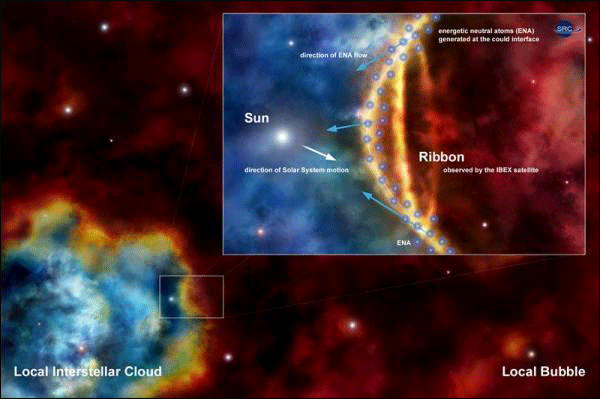
[above] The Sun traveling through the Galaxy happens to cross at the present time a blob of gas about ten light-years across, with a temperature of 6-7 thousand degrees kelvin. This so-called Local Interstellar Cloud is immersed in a much larger expanse of a million-degree hot gas, named the Local Bubble.
The ribbon that astronomers first noticed is actually the boundary where the Local Interstellar Cloud ends and the Local Bubble begins. It's a strange region full of energetic neutral atoms (ENA). These atoms are born out of ions (protons) speeding from the very hot Local Bubble when they exchange charge with the relatively cool atoms "evaporating" from the Local Interstellar Cloud. The newly created ENA have no electrical charge and therefore can dash freely in straight lines from their birth site, oblivious of the impeding magnetic fields. Some of them reach Earth orbit and are detected by IBEX.
What possible effect will the ENA have on our Sun? We'll discuss some strange new particles already coming from our Sun's core that could not only impact the Earth, but could even alter our DNA... next time on viewzone.
Notes:
[1] Gold, T. "Apollo II Observations of a Remarkable Glazing Phenomenon on the Lunar Surface." Science 165 (1969):1345.
[2] Excerpt from Paul LaViolette's 1983 Ph.D. dissertation, "Galactic Explosions, Cosmic Dust Invasions, and Climate Change."
[3] Morgan, Laul, Ganapathy, and Anders (1971 Morgan, J. W., Laul, J. C., Ganapathy, R., and Anders, E. "Glazed Lunar Rocks: Origin by Impact." Science 172(1971):556
[4] The reference is a 1985 Meteoritics paper. See starburstfound.org (superwave tab) for a discussion of this. I did this more particularly to test the theory that a superwave had passed us at the end of the ice age. The result was that I found high levels of cosmic dust on several occasions during the ice age. However, my samples did not span the end of the ice age. So the results were telling more about earlier superwave events. The dating assigned to that ice core was incorrect in those earlier years and it was not until a decade later when additional ice cores were drilled and more accurately dated that I learned that my earliest samples actually began around 23,000 years earlier than I had originally thought.
[5]Anthony L. Peratt, Fellow, IEEE, John McGovern, Alfred H. Qoyawayma, Life Member, IEEE, Marinus Anthony Van der Sluijs, and Mathias G. Peratt, Member, IEEE, "Characteristics for the Occurrence of a High-Current Z-Pinch Aurora as Recorded in Antiquity Part II: Directionality and Source," IEEE Transactions on Plasma Science, Vol. 35, NO. 4, August 2007.
[6] Markus Landgraf, Max Plank Institute.
[7] www.ehteric.com
[8] ScienceDaily November 9, 2010
[9] S. Grzedzielski, M. Bzowski, A. Czechowski, H. O. Funsten, D. J. McComas, N. A. Schwadron. A Possible Generation Mechanism For Theibexribbon From Outside The Heliosphere. The Astrophysical Journal, 2010; 715 (2): L84 DOI: 10.1088/2041-8205/715/2/L84
[10] Beryllium-10 results published by others in the 90's did show there to be evidence of elevated cosmic ray background radiation levels around this time as well as on earlier occasions, thereby supporting my proposal that superwaves have passed through the solar system recurrently.
My cosmic dust study was the first to look at cosmic dust levels in ice age ice. Some researchers did challenge my findings but I showed their criticisms to be unfounded. My results were paradigm shifting and conservative elements in the cosmic dust scientific community were not ready to give up their long held view that cosmic dust concentrations in the solar system do not vary appreciably. Another study looking at levels of cosmic dust "smoke" in ice did support my findings of increased levels during the ice age. There are more recent reports by Firestone et al. of high levels of ET material in sediments dating from around 12,900 years ago. Also high concentrations of ET nanodiamonds have been reported in ice from around that time. But others claim not to confirm the findings of Firestone's group. Since the time of my cosmic dust study no one has undertaken a detailed cosmic dust analysis of polar ice during the period 10,000 to 16,000 years ago to definitively test my cosmic dust theory over this time period. My efforts to get funding were consistently blocked by the old school contingent. The gamma ray burst discussion is not directly relevant to the superwave theory. So you need to correct that as well. They generally originate from evolved X-ray stars. Superwaves on the other hand originate from massive galactic cores. Keep in mind that I am opposed to the black hole theory. I view these objects, not as matter gobbling black holes, but as massive stars that create and expel prodigious quantities of matter and "genic" energy. Although gamma ray bursts could be lethal if they were to originate sufficiently close to the earth, they typically last no longer than a few minutes and so would not be involved in altering climate or affecting the Sun. Superwaves on the other hand can last anywhere from decades to thousands of years.
The relevance of gamma ray bursts and also cosmic ray volleys coming from pulsing X-ray stars is that they support my earlier contention that cosmic ray volleys can propagate through the Galaxy at near the speed of light following rectilinear trajectories. This was a prerequesite if the superwave theory was to be correct. All this evidence came out after my theory had been published and hence can be considered as confirmation of my theory.
[11] Where I say "Another event around 34,000 - 37,000 years ago occurred around the time of the demise of Neanderthal Man." The date of this beryllium-10 peak is now better dated to center at around 40,000 years BP. It does correlate with a climatic event. (Paul LaViolette)
[12] I have posted information about the bubble discovery on the starburst foundation forum at: http://starburstfound.org/superwaveblog/. See the two November 13th postings and also the MSNBC interview posted on November 14th.
[13] "Working with others, we have done Fourier analysis of the Vostok Be-10 record as an indicator of past cosmic ray events. This indicates a recurrence on timescales of ~5700 years, 11,500 years, and ~28,000 years plus large error margins. The values I believe are posted on the starburst website.
It isn't possible to do an accurate check for very long duration cycles like the 100,000 year cycle since the Vostok Be-10 data does not go back far enough. The data does indicate we are overdue for a superwave event at present. It is a bit misleading to infer that the superwave cycles do not match the climatic cycle periods in the data you show. Actually, the 26,000 year Milankovitch cycle has been known for some time and this matches within the error of determination the 28,000 year Be-10 cycle." -- Paul LaViolette.
From Viewzone @ http://www.viewzone.com/expando2.html
PART 3 - CONTINUED
For Part 1 see http://nexusilluminati.blogspot.com/2011/12/has-doomsday-begun-already.html
For further enlightening information enter a word or phrase into the search box @ New Illuminati or click on any label/tag at the bottom of the page @ http://nexusilluminati.blogspot.com
And see
The Her(m)etic Hermit - http://hermetic.blog.com
New Illuminati – http://nexusilluminati.blogspot.com
New Illuminati on Facebook - http://www.facebook.com/pages/New-Illuminati/320674219559
This material is published under Creative Commons Fair Use Copyright (unless an individual item is declared otherwise by copyright holder) – reproduction for non-profit use is permitted & encouraged, if you give attribution to the work & author - and please include a (preferably active) link to the original along with this notice. Feel free to make non-commercial hard (printed) or software copies or mirror sites - you never know how long something will stay glued to the web – but remember attribution! If you like what you see, please send a tiny donation or leave a comment – and thanks for reading this far…
From the New Illuminati – http://nexusilluminati.blogspot.com
Live Net TV is an extraordinary choice to stream satellite TV without paying a penny. There are a lot of channels to look over.
ReplyDeletelive net tv apk
live nettv 4.7
live nettv app
https://apkmist.com/live-nettv-apk/
This comment has been removed by the author.
ReplyDeleteWow, that’s what I was exploring for, what a data! present here
ReplyDeleteat this weblog, thanks admin of this web page.
shareit for pc
xender for pc
shareit pc
xender apk
shareit apk
xender web
shareit for laptop
xender for windows
shareit downloading
xender download
xender for ios
shareit for ios
new year wishes
ReplyDeletenew year quotes
new year images
new year wishes 2020
new year messages 2020
new year messages 2020
buy instagram followers Check out now
ReplyDelete
ReplyDelete192.168.1.254
192.168.0.1 password
192.168 l0 1
This IP address is used by the routers like TP-Link, Netgear, D-Link uses it as the default IP address.
I appreciate you sharing this information. The blog post you wrote is very interesting to me. Your blog post is very informative and interesting. buy real YouTube Views
ReplyDelete